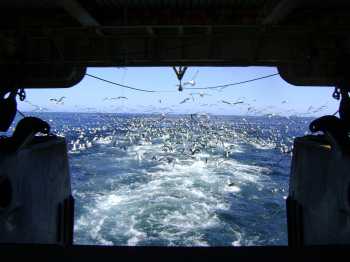Svein Løkkeborg (Fish Capture Division, Institute of Marine Research, Bergen, Norway) has reviewed seabird mitigation measures in longline, trawl and gillnet fisheries, publishing in the journal Marine Ecology Progress Series in August this year.
The open-access paper's abstract follows:
"Growing concerns have been raised about incidental capture of seabirds in various fisheries. Here, studies testing measures to prevent seabird bycatch in longline, trawl and gillnet fisheries are reviewed in order to identify the most efficient mitigation methods. There is potential for considerable reduction in mortality rates in most longline fisheries because effective measures have been developed. However, there is no single solution as the efficiency of a measure is specific to each fishery. In demersal longline fisheries where northern fulmar [Fulmarus glacialis] is the dominant seabird captured, streamer lines have been proven to virtually eliminate mortality. In the fishery for Patagonian toothfish where interactions with albatrosses occur, night setting has resulted in considerable bycatch reductions. Night setting has also been proven to be efficient in pelagic fisheries, but this measure should be used in combination with streamer lines and weighted longlines in areas inhabited by nocturnal and diving birds. The main cause of mortality in trawl fisheries is collision with warp and netsonde cables, but studies are fragmentary. Interactions between cables and seabirds have been shown to be rare at times of no offal discharge, suggesting that a no-discharge policy would virtually eliminate mortality. Streamer lines have been proven to effectively reduce cable strikes under offal discharge. Measures to prevent birds from diving into the trawl net meshes have not been tested. Efficient mitigation methods that maintain target fish catch still have to be identified for gillnet fisheries. Future research in longline fisheries should fine-tune the most promising measures for each specific fishery. Effective measures identified for trawl fisheries need to be expanded to and tested in other areas where seabird interactions occur."

Reference:
Løkkeborg, S. 2011. Best practices to mitigate seabird bycatch in longline, trawl and gillnet fisheries - efficiency and practical applicability. Marine Ecology Progress Series 435: 285-303.
John Cooper, ACAP Information Officer, 7 October 2011

 English
English  Français
Français  Español
Español